Modeling Future Urban Sprawl and Landscape Change in the Laguna de Bay Area, Philippines
Abstract
:1. Introduction
2. Study Area
3. Materials and Methods
3.1. Overview
3.2. LULC Maps of 2007, 2010 and 2015
3.3. Evidence of LULC Change Transition
3.4. Collection and Processing of Data on Potential Driver Variables
3.5. Processing Transition Sub-Models (MLP)
3.6. Change Modeling (Three Scenarios)
3.7. Validation of Modeled Map
4. Results
4.1. 2007–2015 LULC Changes
4.2. LULC Modeling
4.2.1. Potential Explanatory Power of Driver Variables
4.2.2. LULC Change Modeling and its Landscape
4.2.3. LULC Change Statistics
4.3. 2007–2010 Model Validation
5. Discussion
5.1. Influences of Driver Variables Overview
5.2. Scenarios of the Future
5.3. Other Relating Works
5.4. Accomplished Tasks and Future Works
6. Conclusions
Supplementary Materials
Author Contributions
Conflicts of Interest
References
- World Urbanization Prospects: The 2014 Revision (ST/ESA/SER.A/352); Population Division, Department of Economic and Social Affairs, United Nations: New York, NY, USA, 2015.
- Taubenböck, H.; Esch, T.; Felbier, A.; Wiesner, M.; Roth, A.; Dech, S. Monitoring urbanization in mega cities from space. Remote Sens. Environ. 2012, 117, 162–176. [Google Scholar] [CrossRef]
- Gill, S.E.; Handley, J.F.; Ennos, A.R.; Pauleit, S. Adapting Cities for Climate Change: The Role of the Green Infrastructure. Built Environ. 2007, 33, 115–133. [Google Scholar] [CrossRef]
- Satterthwaite, D.; McGranahan, G.; Tacoli, C. Urbanization and its implications for food and farming. Philos. Trans. R. Soc. B 2010, 365, 2809–2820. [Google Scholar] [CrossRef] [PubMed]
- Oliver, T.H.; Morecroft, M.D. Interactions between climate change and land use change on biodiversity: Attribution problems, risks, and opportunities. WIREs Clim. Chang. 2014, 5, 317–335. [Google Scholar] [CrossRef]
- Edelman, D.J. Managing the Urban Environment of Manila. Adv. Appl. Sociol. 2016, 6, 101–133. [Google Scholar] [CrossRef]
- Bürgi, M.; Hersperger, A.M.; Schneeberger, N. Driving forces of landscape change—Current and new directions. Landsc. Ecol. 2004, 19, 857–868. [Google Scholar] [CrossRef]
- Figueroa, F.; Sánchez–Cordero, V.; Meave, J.A.; Trejo, I. Socioeconomic context of land use and land cover change in Mexican biosphere reserves. Environ. Conserv. 2009, 36, 180–191. [Google Scholar] [CrossRef]
- Kolb, M.; Mas, J.F.; Galicia, L. Evaluating drivers and transition potential models in a complex landscape in southern Mexico. Int. J. Geogr. Inf. Sci. 2013, 27, 1804–1827. [Google Scholar] [CrossRef]
- Seto, K.; Güneralp, B.; Hutyra, L. Global forecasts of urban expansion to 2030 and direct impacts on biodiversity and carbon pools. Proc. Natl. Acad. Sci. USA 2012, 109, 16083–16088. [Google Scholar] [CrossRef] [PubMed]
- Han, H.; Yang, C.; Song, J. Scenario Simulation and the Prediction of Land Use and Land Cover Change in Beijing, China. Sustainability 2015, 7, 4260–4279. [Google Scholar] [CrossRef]
- Pitman, A.J.; de Noblet-Ducoudré, N.; Avila, F.B.; Alexander, L.V.; Boisier, J.-P.; Brovkin, V.; Delire, C.; Cruz, F.; Donat, M.G.; Gayler, V.; et al. Effects of land cover change on temperature and rainfall extremes in multi-model ensemble simulations. Earth Syst. Dyn. 2012, 3, 213–231. [Google Scholar]
- Lasco, R.D.; Pulhin, F.B. Forest land use change in the Philippines and climate change mitigation. Mitig. Adapt. Strateg. Glob. Chang. 2000, 5, 81–97. [Google Scholar] [CrossRef]
- Malaque, I.R.; Yokohari, M. Urbanization process and the changing agricultural landscape pattern in the urban fringe of Metro Manila, Philippines. Environ. Urban 2007, 19, 191–206. [Google Scholar] [CrossRef]
- Murakami, A.; Palijon, A.M. Urban Sprawl and Land Use Characteristics in the Urban Fringe of Metro Manila, Philippines. J. Asian Archit. Build. Eng. 2005, 1, 177–183. [Google Scholar] [CrossRef]
- Alexandratos, N.; Bruinsma, J. World Agriculture towards 2030/2050: The 2012 Revision; ESA Working Paper No. 12-03; FAO: Rome, Italy, 2012. [Google Scholar]
- Perry, D.A.; Oren, R.; Hart, S.C. Forest Ecosystems, 2nd ed.; The Johns Hopkins University Press: Baltimore, MD, USA, 2008. [Google Scholar]
- Rola, A.C.; Sajise, J.A.U.; Harder, D.; Alpuerto, J.M. Soil conservation decision and upland corn productivity: A Philippine case study. Asian J. Agric. Dev. 2009, 6, 1–19. [Google Scholar]
- Briones, R.U.; Ella, V.B.; Bantayan, N.C. Hydrologic Impact Evaluation of Land Use and Land Cover Change in Palico Watershed, Batangas, Philippines Using the SWAT Model. J. Environ. Sci. Manag. 2016, 19, 96–107. [Google Scholar]
- Tongson, E.E.; Faraon, A.A. Hydrologic Atlas of Laguna de Bay 2012; Laguna Lake Development Authority and WWF-Philippines: Quezon City, Philippines, 2012. [Google Scholar]
- Murayama, Y.; Estoque, R.C.; Subasinghe, S.; Hou, H.; Gong, H. Land-Use/Land-Cover Changes in Major Asian and African Cities. Ann. Rep. Multi Use Soc. Econ. Data Bank 2015, 92, 11–58. [Google Scholar]
- Boori, M.S.; Choudhary, K.; Kupriyanov, A.; Kovelskiy, V. Satellite data for Singapore, Manila and Kuala Lumpur city growth analysis. Data Brief. 2016, 7, 1576–1583. [Google Scholar] [CrossRef] [PubMed]
- Abino, A.C.; Kim, S.Y.; Jang, M.N.; Lee, Y.J.; Chung, J.S. Assessing land use and land cover of the Marikina sub-watershed, Philippines. Forest Sci. Technol. 2015, 11, 65–75. [Google Scholar] [CrossRef]
- Global Footprint Network. Ecological Footprint Report: Restoring Balance in Laguna Lake Region; Global Footprint Network: Oakland, CA, USA, 2013. [Google Scholar]
- Wealth Accounting and the Valuation of Ecosystem Services (WAVES). Ecosystem Accounts Inform Policies for Better Resource Management of Laguna de Bay. Available online: https://www.wavespartnership.org/en/knowledge-center/ecosystem-accounts-inform-policies-better-resource-management-laguna-de-bay (accessed on 20 March 2017).
- Rañola, R.F., Jr.; Rañola, F.M.; Casin, C.S.; Tan, M.F.O. LakeHEAD Progress Report: The Social and Economic Basis for Managing Environmental Risk for Sustainable Food and Health in Watershed Planning: The Case of Silang-Sta; Rosa Sub-Watershed Communities in Lake Laguna Region; Research Institute for Humanity and Nature: Kyoto, Japan, 2010–2011. [Google Scholar]
- Mishra, V.N.; Rai, P.K.; Mohan, K. Prediction of land use changes based on land change modeler (LCM) using remote sensing: A case study of Muzaffarpur (Bihar), India. J. Geogr. Inst. Jovan Cvijic 2014, 64, 111–127. [Google Scholar] [CrossRef]
- Fathizad, H.; Rostami, N.; Faramarzi, M. Detection and prediction of land cover changes using Markov chain model in semi-arid rangeland in western Iran. Environ. Monit. Assess. 2015, 187, 629. [Google Scholar] [CrossRef] [PubMed]
- Megahed, Y.; Cabral, P.; Silva, J.; and Caetano, M. Land Cover Mapping Analysis and Urban Growth Modelling Using Remote Sensing Techniques in Greater Cairo Region—Egypt. ISPRS Int. J. Geo Inf. 2015, 4, 1750–1769. [Google Scholar] [CrossRef]
- Agarwal, C.; Green, G.M.; Grove, J.M.; Evans, T.P.; Schweik, C.M. A Review and Assessment of Land-Use Change Models Dynamics of Space, Time, and Human Choice; U.S. Dept. of Agriculture: Quilcene, WA, USA; Forest Service: Washington, DC, USA; Northeastern Research Station: Newtown Square, PA, USA, 2002.
- National Research Council. Advancing Land Change Modeling: Opportunities and Research Requirements. Chapter: 2 Land Change Modeling Approaches; The National Academies Press: Washington, DC, USA, 2014. [Google Scholar]
- Triantakonstantis, D.; Stathakis, D. Urban growth prediction in Athens, Greece, using Artificial Neural Networks. Int. J. Civil Environ. Struct. Construct. Archit. Eng. 2015, 9, 234–238. [Google Scholar]
- Grekousis, G.; Manetos, P.; Photis, Y.N. Modeling urban evolution using neural networks, fuzzy logic and GIS: The case of the Athens metropolitan area. Cities 2013, 30, 193–203. [Google Scholar] [CrossRef]
- Zhai, R.; Zhang, C.; Li, W.; Boyer, M.A.; Hanink, D. Prediction of Land Use Change in Long Island Sound Watersheds Using Nighttime Light Data. Land 2016, 5, 44. [Google Scholar] [CrossRef]
- Ahmed, B.; Ahmed, R. Modeling Urban Land Cover Growth Dynamics Using Multi-Temporal Satellite Images: A Case Study of Dhaka, Bangladesh. ISPRS Int. J. Geo Inf. 2012, 1, 3–31. [Google Scholar] [CrossRef]
- Olmedo, M.T.C.; Pontius, R.G., Jr.; Paegelow, M.; Mas, J.-M. Comparison of simulation models in terms of quantity and allocation of land change. Environ. Model. Softw. 2015, 69, 214–221. [Google Scholar] [CrossRef]
- Riccioli, F.; El Asmar, T.; El Asmar, J.P.; Fagarazzi, C.; Casini, L. Artificial neural network for multifunctional areas. Environ. Monit. Assess. 2016, 188, 67. [Google Scholar] [CrossRef] [PubMed]
- Wang, W.; Zhang, C.; Allen, J.M.; Li, W.; Boyer, M.A.; Segerson, K.; Silander, J.A. Analysis and Prediction of Land Use Changes Related to Invasive Species and Major Driving Forces in the State of Connecticut. Land 2016, 5, 25. [Google Scholar] [CrossRef]
- Chaudhuri, G.; Clarke, K. The SLEUTH and land use change model: A review. Environ. Resour. Res. 2013, 1, 88–105. [Google Scholar]
- Pontius Jr, R.G.; Boersma, W.; Castella, J.-C.; Clarke, K.; de Nijs, T.; Dietzel, C.; Duan, Z.; Fotsing, E.; Goldstein, N.; Kok, K.; et al. Comparing the input, output, and validation maps for several models of land change. Ann. Reg. Sci. 2008, 42, 11–47. [Google Scholar] [CrossRef]
- Clark Labs. TerrSet Geospatial Monitoring and Modeling Software; Clark Labs, Clark University: Worcester, MA, USA, 2015. [Google Scholar]
- Laguna Lake Development Authority, Water Quality Report: Laguna de Bay and Its Tributaries. Available online: http://www.llda.gov.ph/index.php?option=com_content&view=article&id=218&Itemid=679 (accessed on 20 March 2017).
- Google Earth, V 7.1.8.3036. (24 March 2016), Laguna de Bay, Philippines, 14.340535°N, 121.241762°E, Eye alt 62.90 km. DigitalGlobe 2016, Google 2016, CNES/Astrium 2016. Available online: http://www.earth.google.com (accessed on 20 March 2017).
- Johnson, B.A.; Iizuka, K.; Bragais, M.; Endo, I.; Magcale-Macandog, D. Employing crowdsourced geographic data and multi-temporal/multi-sensor satellite imagery to monitor land cover change: A case study in an urbanizing region of the Philippines. Comput. Environ. Urban Syst. 2017, 64, 184–193. [Google Scholar] [CrossRef]
- Lambin, E.F.; Turner, B.L.; Geist, H.J.; Agbola, S.B.; Angelsen, A.; Bruce, J.W.; Coomes, O.T.; Dirzo, R.; Fischer, G.; Folke, C.; et al. The causes of land-use and land-cover change: Moving beyond the myths. Glob. Environ. Chang. 2001, 11, 261–269. [Google Scholar] [CrossRef]
- Lambin, E.F.; Geist, H.J.; Lepers, E. Dynamics of land-use and land-cover change in tropical regions. Annu. Rev. Environ Resour. 2003, 28, 205–241. [Google Scholar] [CrossRef]
- PhilGIS—Philippines GIS Data Clearinghouse. Available online: https://www.philgis.org/ (accessed on 20 March 2017).
- EarthExplorer (USGS). Available online: https://earthexplorer.usgs.gov/ (accessed on 20 March 2017).
- OpenStreetMap—GEOFABRIK Downloads. Available online: http://download.geofabrik.de/asia/philippines.html (accessed on 3 March 2016 ).
- NOAA Earth Observtion Group (EOG). Available online: https://ngdc.noaa.gov/eog/ (accessed on 20 March 2017).
- WorldPop. Available online: http://www.worldpop.org.uk/ (accessed on 20 March 2017).
- WorldClim—Global Climate Data. Available online: http://www.worldclim.org/ (accessed on 20 March 2017).
- Hijmans, R.J.; Cameron, S.E.; Parra, J.L.; Jones, P.G.; Jarvis, A. Very high resolution interpolated climate surfaces for global land areas. Int J Climatol. 2005, 25, 1965–1978. [Google Scholar] [CrossRef]
- O’Donnell, M.S.; Ignizio, D.A. Bioclimatic Predictors for Supporting Ecological Applications in the Conterminous United States; U.S. Geological Survey Data Series 691; U.S. Geological Survey: Reston, VA, USA, 2012.
- Van Wart, J.; van Bussel, L.G.J.; Wolf, J.; Licker, R.; Grassini, P.; Nelson, A.; Boogaard, H.; Gerber, J.; Mueller, N.D.; Claessens, L.; et al. Use of agro-climatic zones to upscale simulated crop yield potential. Field Crops Res. 2013, 143, 44–55. [Google Scholar] [CrossRef]
- Kim, I.; Le, Q.B.; Park, S.J.; Tenhunen, J.; Koellner, T. Driving Forces in Archetypical Land-Use Changes in a Mountainous Watershed in East Asia. Land 2014, 3, 957–980. [Google Scholar] [CrossRef]
- Ruan, X.; Qiu, F.; Dyck, M. The effects of environmental and socioeconomic factors on land-use changes: A study of Alberta, Canada. Environ. Monit. Assess. 2016, 188, 446. [Google Scholar] [CrossRef] [PubMed]
- Mellander, C.; Lobo, J.; Stolarick, K.; Matheson, Z. Night-Time Light Data: A Good Proxy Measure for Economic Activity? PLoS ONE 2015, 10, e0139779. [Google Scholar] [CrossRef] [PubMed]
- Stathakis, D. Forecasting Urban Expansion Based on Night Lights. Int. Arch. Photogramm. Remote Sens. Spat. Inf. Sci. 2016, XLI-B8, 1049–1054. [Google Scholar] [CrossRef]
- Stevens, F.R.; Gaughan, A.E.; Linard, C.; Tatem, A.J. Disaggregating Census Data for Population Mapping Using Random Forests with Remotely-Sensed and Ancillary Data. PLoS ONE 2015, 10, e0107042. [Google Scholar] [CrossRef] [PubMed]
- Linard, C.; Gilbert, M.; Snow, R.W.; Noor, A.M.; Tatem, A.J. Population Distribution, Settlement Patterns and Accessibility across Africa in 2010. PLoS ONE 2012, 7, e31743. [Google Scholar] [CrossRef] [PubMed]
- Mas, J.F.; Puig, H.; Palacio, J.L.; Lopez, A.S. Modelling deforestation using GIS and artificial neural networks. Environ. Model. Softw. 2004, 19, 461–471. [Google Scholar] [CrossRef]
- Yuan, H.; Van Der Wiele, C.F.; Khorram, S. An automated artificial neural network system for land use/land cover classification from Landsat TM imagery. Remote Sens. 2009, 1, 243–265. [Google Scholar] [CrossRef]
- Eastman, J.R. TerrSet Help File; Clark University: Worcester, MA, USA, 2015. [Google Scholar]
- Takada, T.; Miyamoto, A.; Hasegawa, F.S. Derivation of a yearly transition probability matrix for land-use dynamics and its applications. Landsc Ecol. 2010, 24, 561–572. [Google Scholar] [CrossRef]
- Estoque, R.C.; Murayama, Y. Corrigendum to ‘Examining the potential impact of land use/cover changes on the ecosystem services of Baguio city, the Philippines: A Scenario-based analysis’. Appl. Geogr. 2012, 35, 316–326. [Google Scholar]
- Pontius, R.G. Quantification error versus location error in comparison of categorical maps. Photogramm. Eng. Remote Sens. 2000, 66, 1011–1016. [Google Scholar]
- Google Earth, V 7.1.8.3036. (31 December 1984; 30 December 1990; 31 December 1996; 31 December 2002; 31 December 2008), Laguna de Bay, Philippines, 14.340535°N, 121.241762°E, Eye alt 62.90 km. Landsat/Copernicus. Available online: http://www.earth.google.com (accessed on 20 March 2017).
- Iizuka, K.; Tateishi, R. Estimation of CO2 Sequestration by the Forests in Japan by Discriminating Precise Tree Age Category using Remote Sensing Techniques. Remote Sens. 2015, 7, 15082–15113. [Google Scholar] [CrossRef]
- National Greening Program, Department of Environment and Natural Resrouces. Available online: http://www.denr.gov.ph/priority-programs/national-greening-program.html (accessed on 20 March 2017).
- Wijesekara, G.N.; Farjad, B.; Gupta, A.; Qiao, Y.; Delaney, P.; Marceau, D.J. A comprehensive land-use/hydrological modeling system for scenario simulations in the Elbow River Watershed, Alberta, Canada. Environ Manag. 2014, 53, 357–381. [Google Scholar] [CrossRef] [PubMed]
- Losiri, C.; Nagai, M.; Ninsawat, S.; Shrestha, R.P. Modeling Urban Expansion in Bangkok Metropolitan Region Using Demographic–Economic Data through Cellular Automata-Markov Chain and Multi-Layer Perceptron-Markov Chain Models. Sustainability 2016, 8, 686. [Google Scholar] [CrossRef]
- Dale, V. The Relationship between Land-Use Change and Climate Change. Ecol. Appl. 1997, 7, 753–769. [Google Scholar] [CrossRef]
- Zhang, Y.; Smith, J.A.; Luo, L.; Wang, Z.; Baeck, M.L. Urbanization and Rainfall Variability in the Beijing Metropolitan Region. J. Hydrometeorol. 2014, 15, 2219–2235. [Google Scholar] [CrossRef]
- Bravo, L.; Roque, V.G.; Brett, J.; Dizon, R.; L’Azou, M. Epidemiology of Dengue Disease in the Philippines (2000–2011): A Systematic Literature Review. PLoS Negl. Trop. Dis. 2014, 8, e3027. [Google Scholar] [CrossRef] [PubMed]
- Su, G. Correlation of Climatic Factors and Dengue Incidence in Metro Manila, Philippines. Ambio 2008, 37, 292–294. [Google Scholar] [CrossRef]
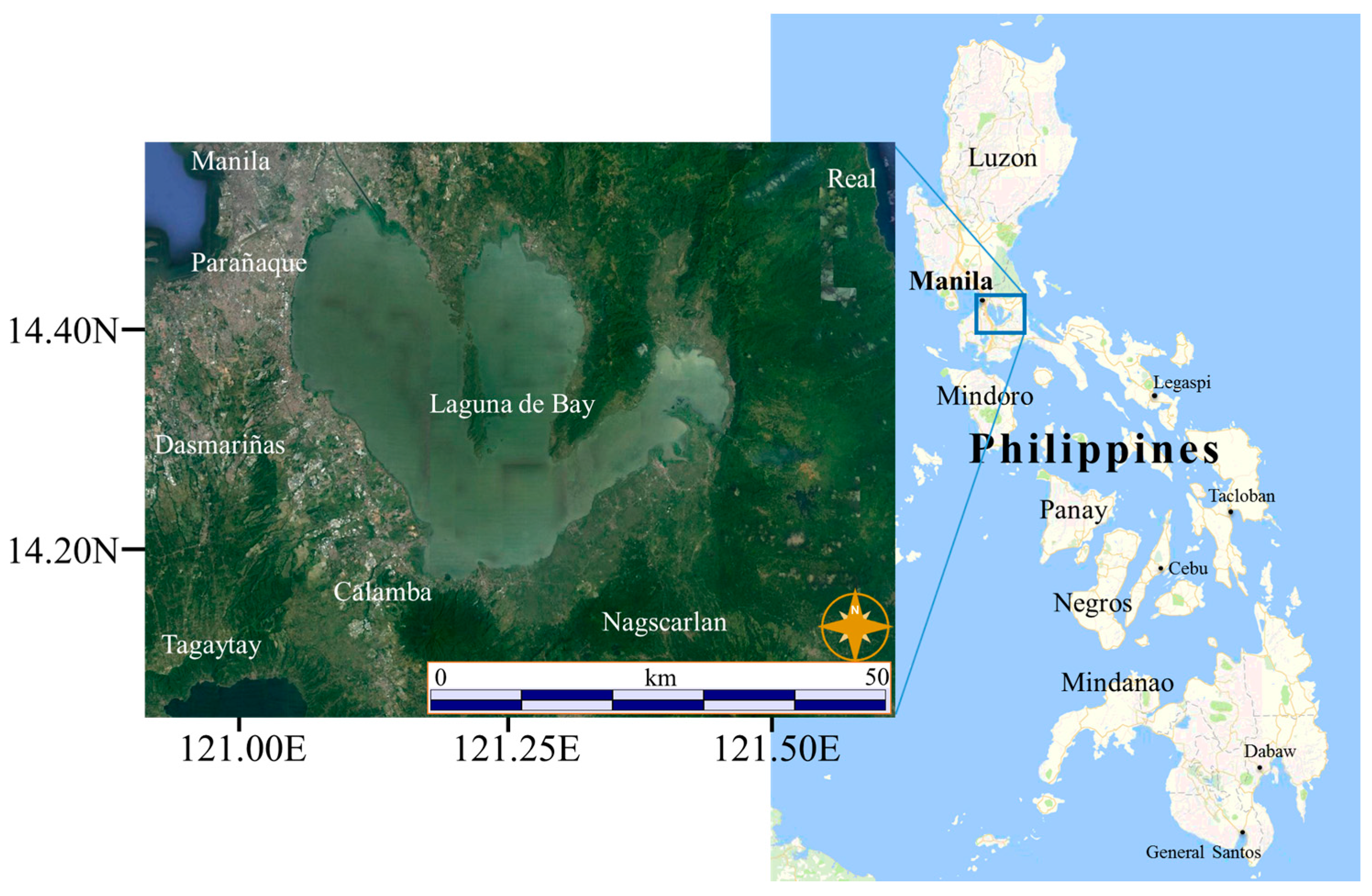

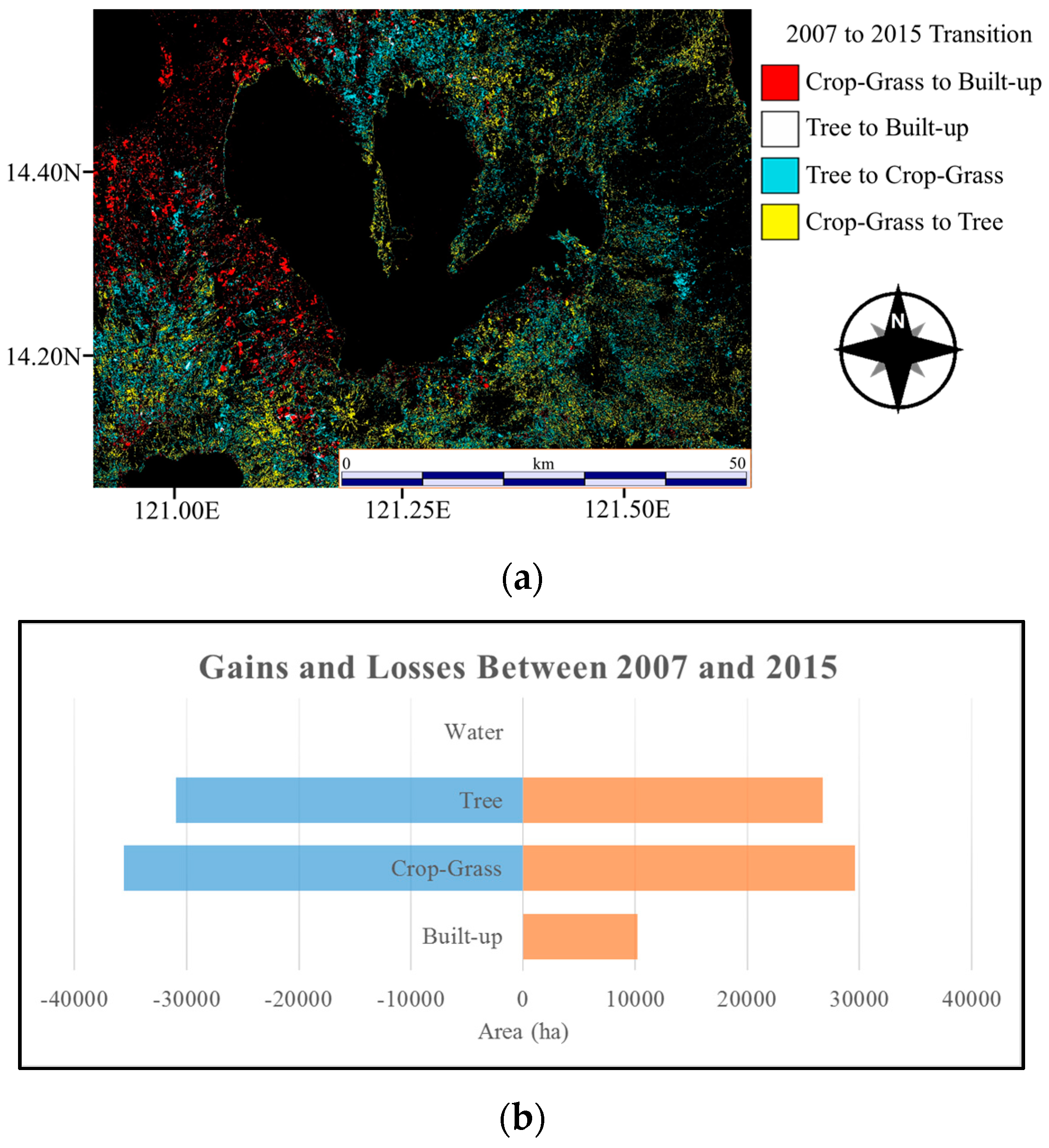

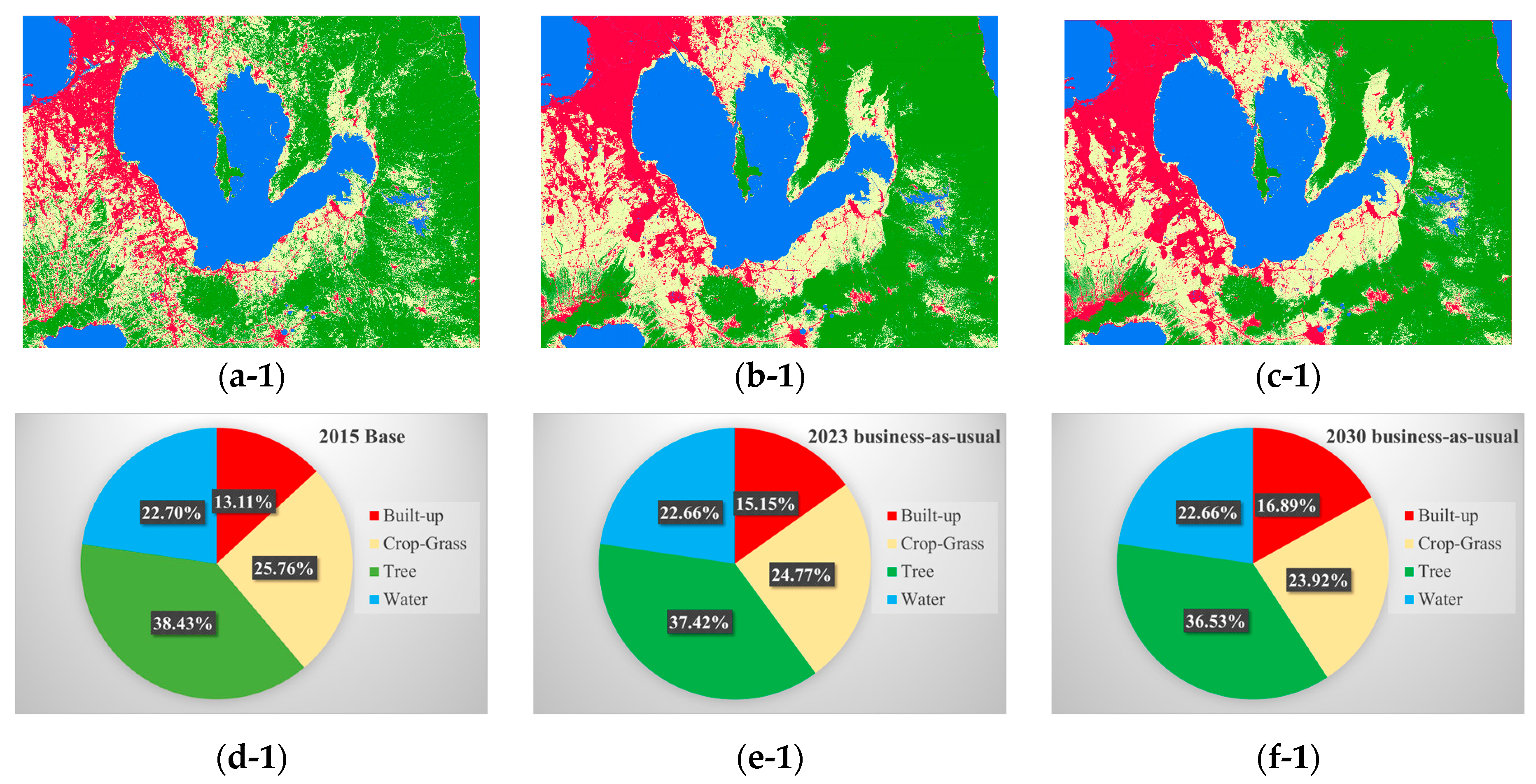
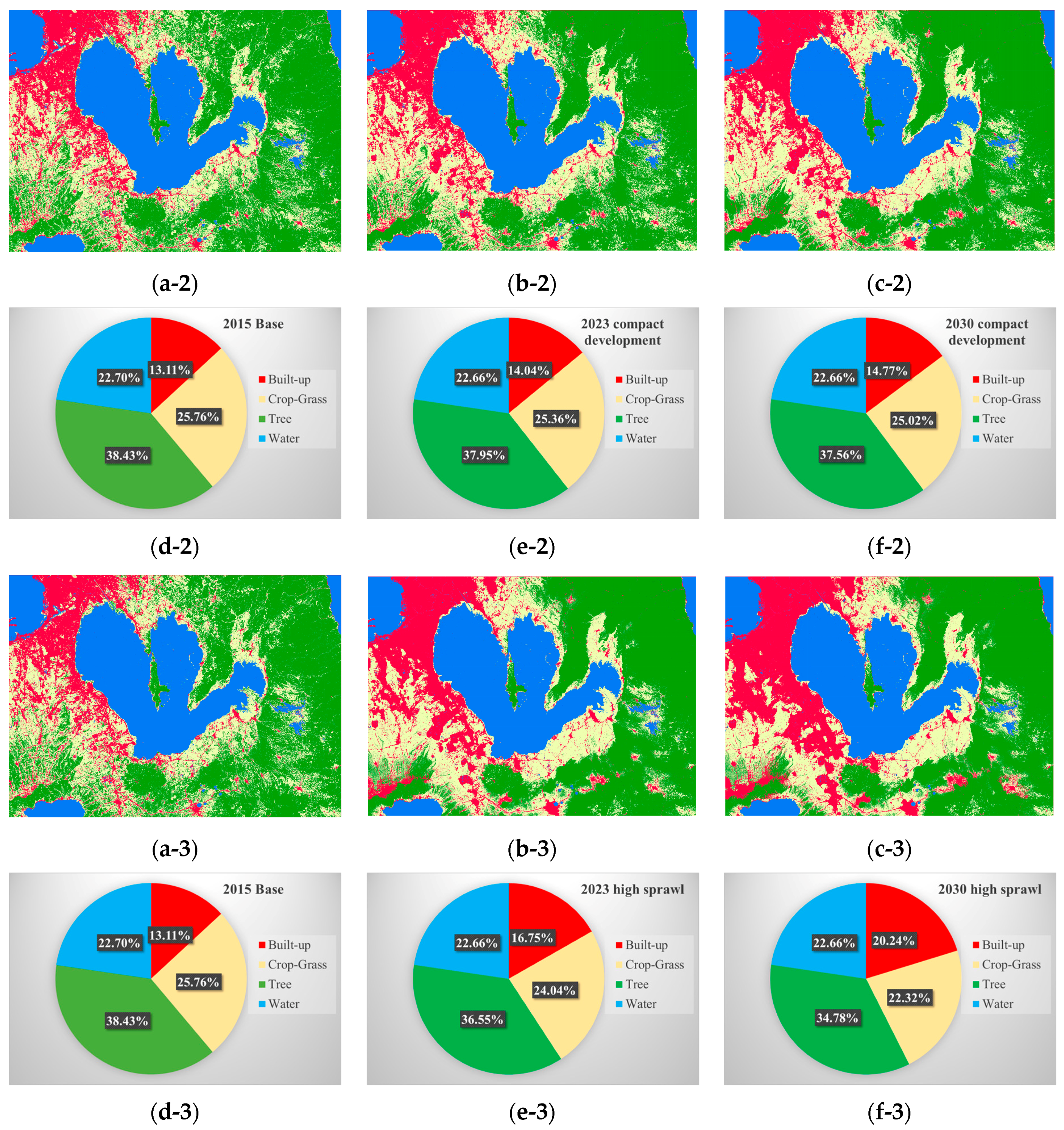
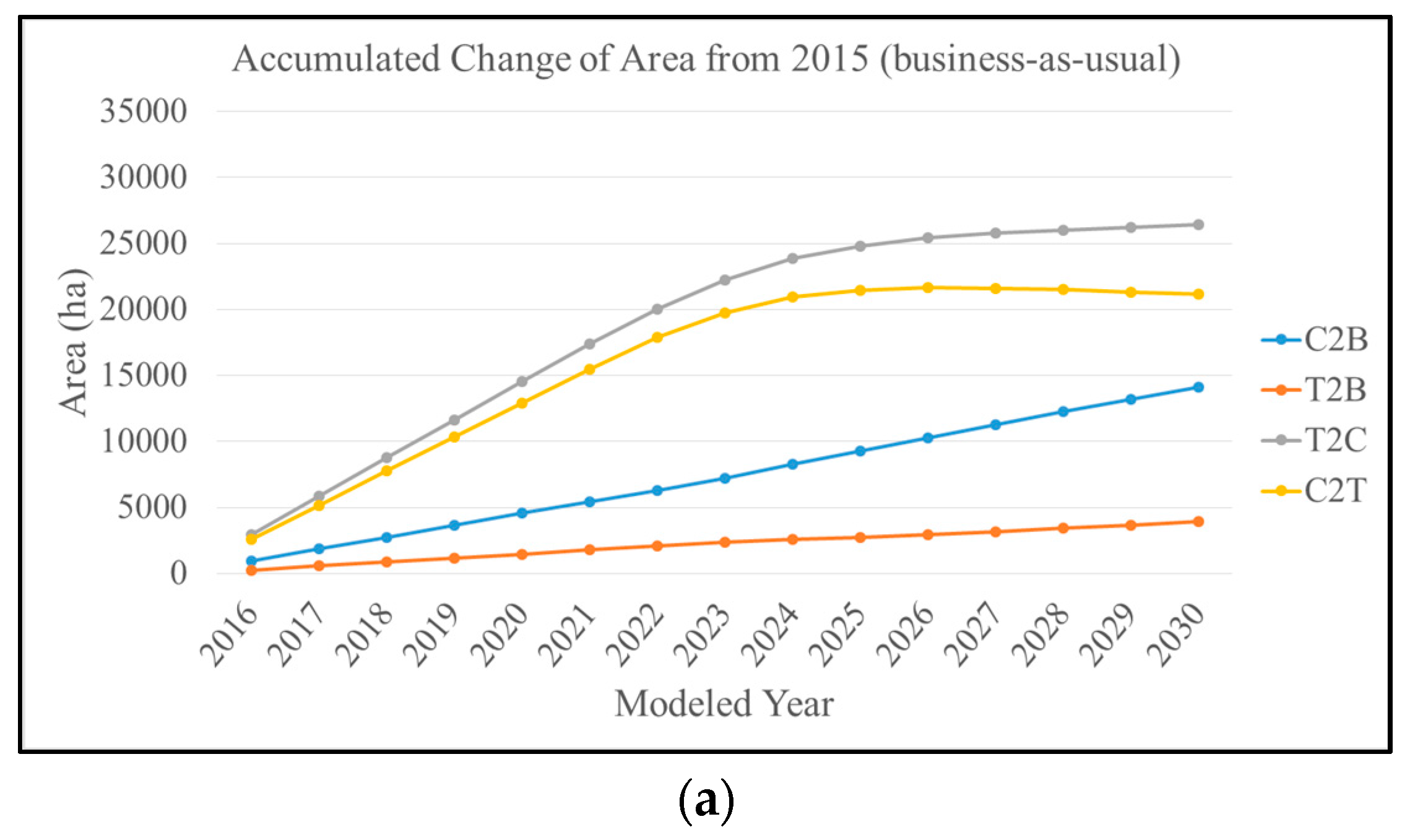

| Category | Driver | Abbreviation | Unit | Year | Data Source |
|---|---|---|---|---|---|
| Climate | Annual Mean Temperature | BIO1 | °C | 1960–1990 | PhilGIS [47] |
| Mean Diurnal Range | BIO2 | ||||
| Isothermality | BIO3 | % | |||
| Temperature Seasonality | BIO4 | °C | |||
| Max. Temperature of Warmest Month | BIO5 | ||||
| Min. Temperature of Coldest Month | BIO6 | ||||
| Temperature Annual Range | BIO7 | ||||
| Mean Temperature of Wettest Quarter | BIO8 | ||||
| Mean Temperature of Driest Quarter | BIO9 | ||||
| Mean Temperature of Warmest Quarter | BIO10 | ||||
| Mean Temperature of Coldest Quarter | BIO11 | ||||
| Annual Precipitation | BIO12 | mm | |||
| Precipitation of Wettest Month | BIO13 | ||||
| Precipitation of Driest Month | BIO14 | ||||
| Precipitation Seasonality | BIO15 | % | |||
| Precipitation of Wettest Quarter | BIO16 | mm | |||
| Precipitation of Driest Quarter | BIO17 | ||||
| Precipitation of Warmest Quarter | BIO18 | ||||
| Precipitation of Coldest Quarter | BIO19 | ||||
| Topography | Elevation | DEM | m | 2000 | SRTM [48] |
| Slope | Slope | degrees | |||
| Aspect | Aspect | ||||
| Spatial Context | Distance from Built-up | Dist_Built | Lat/Long degrees | 2007 | Classified LULC 2007 |
| Distance from Crop-Grass | Dist_Crop | ||||
| Distance from Trees | Dist_Tree | ||||
| Distance from Water | Dist_Water | ||||
| Distance from Primary Road | Dist_Road1 | 3 March 2016 | OpenStreetMap [49] | ||
| Distance from Secondary Road | Dist_Road2 | ||||
| Distance from Tertiary Road | Dist_Road3 | ||||
| Distance from Other Roads | Dist_Road4 | ||||
| Distance from Canal | Dist_Canal | ||||
| Distance from River | Dist_River | ||||
| Distance from Stream | Dist_Stream | ||||
| Distance from Golf Course | Dist_Golf | 2004 | PhilGIS [47] | ||
| Distance from Protected Area | Dist_Protect | 2013 | |||
| Nightlight Data | Night Light Data 2007 | NL_2007 | DN | 2007 | NOAA Earth Observation Group [50] |
| Night Light Data 2015 | NL_2015 | nanoWatts/cm2/sr | 2015 | ||
| Night Light Change 2007 to 2015 | NL_Ch | - | |||
| Population | Population Map 2007 | Pop_2007 | People per hectare | 2007 | WorldPop [51] |
| Population Map 2015 | Pop_2015 | 2015 | |||
| Population Change 2007 to 2015 | Pop_Ch | - |
| Probability of changing to (2030): | |||||
|---|---|---|---|---|---|
| Built-Up | Crop-Grass | Trees | Water | ||
| LULC Given (2015) | Built-Up | 1.0000 | 0.0000 | 0.0000 | 0.0000 |
| Crop-Grass | 0.1137 | 0.5745 | 0.3118 | 0.0000 | |
| Trees | 0.0211 | 0.2372 | 0.7417 | 0.0000 | |
| Water | 0.0000 | 0.0000 | 0.0000 | 1.0000 | |
| Variable | |||||||||
|---|---|---|---|---|---|---|---|---|---|
| BIO3 | BIO6 | BIO7 | BIO12 | BIO15 | BIO19 | DEM | Slope | Dist-Built | |
| Overall | 0.3426 | 0.4680 | 0.4208 | 0.3250 | 0.4934 | 0.3757 | 0.6107 | 0.5649 | 0.3609 |
| Built-up | 0.2769 | 0.2908 | 0.2815 | 0.2803 | 0.5390 | 0.2748 | 0.4411 | 0.3142 | 0.3517 |
| Crop-Grass | 0.1242 | 0.1934 | 0.2315 | 0.1095 | 0.2223 | 0.1603 | 0.3273 | 0.3434 | 0.3583 |
| Trees | 0.4517 | 0.6166 | 0.6078 | 0.4476 | 0.6069 | 0.5680 | 0.6465 | 0.6220 | 0.2905 |
| Water | 0.4382 | 0.6450 | 0.5032 | 0.3886 | 0.5268 | 0.4256 | 0.8902 | 0.8400 | 0.4193 |
| Dist_Crop | Dist_Tree | Dist_Water | Road_Dist1 | Road_Dist2 | Road_Dist3 | Road_Dist4 | Road_River | Road_Canal | |
| Overall | 0.4469 | 0.5144 | 0.4352 | 0.3046 | 0.3767 | 0.3793 | 0.3921 | 0.3398 | 0.4165 |
| Built-Up | 0.1702 | 0.1664 | 0.2347 | 0.3634 | 0.4570 | 0.3979 | 0.3749 | 0.2757 | 0.4865 |
| Crop-Grass | 0.2912 | 0.2890 | 0.1899 | 0.2226 | 0.2815 | 0.3151 | 0.3746 | 0.2452 | 0.1678 |
| Trees | 0.2946 | 0.4073 | 0.6398 | 0.2488 | 0.3686 | 0.2974 | 0.2387 | 0.1875 | 0.5701 |
| Water | 0.7692 | 0.8848 | 0.5588 | 0.3390 | 0.3628 | 0.4630 | 0.5084 | 0.5261 | 0.3484 |
| Dist_Stream | Dist_Golf | Dist_Protect | Pop_2007 | Pop_2015 | P0p_Ch | NL_2007 | NL_2015 | NL_Ch | |
| Overall | 0.3612 | 0.3149 | 0.2484 | 0.4943 | 0.4910 | 0.5363 | 0.4659 | 0.4047 | 0.3218 |
| Built-Up | 0.3735 | 0.3941 | 0.2070 | 0.7183 | 0.7180 | 0.7132 | 0.6368 | 0.6597 | 0.4658 |
| Crop-Grass | 0.3159 | 0.1679 | 0.2147 | 0.3932 | 0.3838 | 0.4545 | 0.2989 | 0.1654 | 0.1922 |
| Trees | 0.3313 | 0.3677 | 0.2214 | 0.3731 | 0.3722 | 0.3477 | 0.5213 | 0.3142 | 0.3649 |
| Water | 0.4078 | 0.2746 | 0.3285 | 0.3308 | 0.3234 | 0.5002 | 0.2907 | 0.2046 | 0.1289 |
| Variable Name | Model | Accuracy (%) | Influence Order | ||||||
|---|---|---|---|---|---|---|---|---|---|
| With all variables | (a) | (b) | (c) | (d) | (a) | (b) | (c) | (d) | |
| 74.21 | 70.37 | 90.91 | 74.31 | N/A | |||||
| BIO3 | Var.1 constant | 74.00 | 70.39 | 90.90 | 74.35 | 13 | 19 | 15 | 24 |
| BIO6 | Var.2 constant | 73.98 | 70.21 | 90.91 | 74.34 | 12 | 9 | 20 | 23 |
| BIO7 | Var.3 constant | 74.16 | 70.38 | 90.91 | 74.29 | 21 | 18 | 21 | 20 |
| BIO12 | Var.4 constant | 74.27 | 70.35 | 90.84 | 74.36 | 27 | 14 | 10 | 26 |
| BIO15 | Var.5 constant | 73.62 | 70.39 | 90.99 | 74.26 | 5 | 20 | 24 | 18 |
| BIO19 | Var.6 constant | 74.24 | 70.39 | 90.90 | 74.36 | 25 | 21 | 16 | 25 |
| DEM | Var.7 constant | 73.54 | 68.01 | 90.84 | 73.21 | 4 | 1 | 11 | 3 |
| Slope | Var.8 constant | 73.82 | 68.41 | 90.52 | 71.01 | 10 | 2 | 7 | 1 |
| Dist_Built | Var.9 constant | 74.16 | 70.39 | 90.92 | 74.14 | 20 | 22 | 22 | 15 |
| Dist_Crop | Var.10 constant | 74.21 | 70.37 | 90.91 | 74.30 | 23 | 17 | 18 | 21 |
| Dist_Tree | Var.11 constant | 74.21 | 70.37 | 90.91 | 74.31 | 22 | 16 | 17 | 22 |
| Dist_Water | Var.12 constant | 74.09 | 69.94 | 90.50 | 74.13 | 16 | 5 | 6 | 14 |
| Road_Dist1 | Var.13 constant | 74.15 | 70.31 | 90.99 | 74.02 | 17 | 10 | 25 | 6 |
| Road_Dist2 | Var.14 constant | 73.76 | 70.34 | 91.08 | 74.07 | 9 | 12 | 27 | 7 |
| Road_Dist3 | Var.15 constant | 74.08 | 70.21 | 91.00 | 73.92 | 15 | 8 | 26 | 5 |
| Road_Dist4 | Var.16 constant | 74.15 | 70.35 | 90.91 | 73.87 | 18 | 13 | 19 | 4 |
| Dist_Canal | Var.17 constant | 74.26 | 69.20 | 89.15 | 73.07 | 26 | 3 | 3 | 2 |
| Dist_River | Var.18 constant | 74.15 | 70.33 | 90.92 | 74.16 | 19 | 11 | 23 | 16 |
| Dist_Stream | Var.19 constant | 74.24 | 70.41 | 90.89 | 74.10 | 24 | 24 | 13 | 10 |
| Dist_Golf | Var.20 constant | 74.06 | 70.43 | 90.82 | 74.13 | 14 | 25 | 9 | 13 |
| Dist_Protect | Var 21 constant | 73.76 | 69.57 | 90.89 | 74.09 | 8 | 4 | 14 | 9 |
| NL_2007 | Var.22 constant | 73.67 | 70.36 | 90.12 | 74.10 | 7 | 15 | 5 | 11 |
| NL_2015 | Var.23 constant | 72.98 | 70.53 | 90.59 | 74.28 | 1 | 27 | 8 | 19 |
| NL_Ch | Var.24 constant | 73.38 | 70.47 | 90.85 | 74.37 | 3 | 26 | 12 | 27 |
| Pop_2007 | Var.25 constant | 73.30 | 70.10 | 88.55 | 74.08 | 2 | 6 | 1 | 8 |
| Pop_2015 | Var.26 constant | 73.64 | 70.12 | 88.74 | 74.11 | 6 | 7 | 2 | 12 |
| Pop_Ch | Var.27 constant | 73.82 | 70.39 | 89.90 | 74.22 | 11 | 23 | 4 | 17 |
© 2017 by the authors. Licensee MDPI, Basel, Switzerland. This article is an open access article distributed under the terms and conditions of the Creative Commons Attribution (CC BY) license (http://creativecommons.org/licenses/by/4.0/).
Share and Cite
Iizuka, K.; Johnson, B.A.; Onishi, A.; Magcale-Macandog, D.B.; Endo, I.; Bragais, M. Modeling Future Urban Sprawl and Landscape Change in the Laguna de Bay Area, Philippines. Land 2017, 6, 26. https://doi.org/10.3390/land6020026
Iizuka K, Johnson BA, Onishi A, Magcale-Macandog DB, Endo I, Bragais M. Modeling Future Urban Sprawl and Landscape Change in the Laguna de Bay Area, Philippines. Land. 2017; 6(2):26. https://doi.org/10.3390/land6020026
Chicago/Turabian StyleIizuka, Kotaro, Brian A. Johnson, Akio Onishi, Damasa B. Magcale-Macandog, Isao Endo, and Milben Bragais. 2017. "Modeling Future Urban Sprawl and Landscape Change in the Laguna de Bay Area, Philippines" Land 6, no. 2: 26. https://doi.org/10.3390/land6020026







